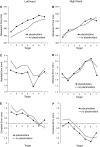Left hand, but not right hand, reaching is sensitive to visual context
- PMID: 20300930
- PMCID: PMC2862955
- DOI: 10.1007/s00221-010-2214-6
Left hand, but not right hand, reaching is sensitive to visual context
Abstract
Recently, it has been reported that grasping with the left hand is more vulnerable to visual size illusions than grasping with the right hand. The present study investigated whether this increased sensitivity of the left hand for visual context extends to reaching. Left- and right-handed participants reached for targets embedded in two different visual contexts with either left or right hands. Visual context was manipulated by presenting targets either in a blank field or within an array of placeholders marking possible target locations. Regardless of handedness, the presence of placeholders affected left hand, but not right hand, reaching by improving end-point accuracy and reducing movement speed. Furthermore, left hand reaching was more accurate for far than near targets, whereas right hand reaching showed the opposite pattern. We discuss two possible hemispheric lateralization accounts of these findings.
Figures


Similar articles
-
Handedness and Graspability Modify Shifts of Visuospatial Attention to Near-Hand Objects.PLoS One. 2017 Jan 26;12(1):e0170542. doi: 10.1371/journal.pone.0170542. eCollection 2017. PLoS One. 2017. PMID: 28125635 Free PMC article. Clinical Trial.
-
Haptic information differentially interferes with visual analysis in reaching-grasping control and in perceptual processes.Neuroreport. 1998 Mar 30;9(5):887-91. doi: 10.1097/00001756-199803300-00023. Neuroreport. 1998. PMID: 9579685 Clinical Trial.
-
Programming of left hand exploits task set but that of right hand depends on recent history.Exp Brain Res. 2017 Jul;235(7):2215-2224. doi: 10.1007/s00221-017-4964-x. Epub 2017 Apr 27. Exp Brain Res. 2017. PMID: 28451736
-
Left handedness does not extend to visually guided precision grasping.Exp Brain Res. 2007 Sep;182(2):275-9. doi: 10.1007/s00221-007-1090-1. Epub 2007 Aug 24. Exp Brain Res. 2007. PMID: 17717653
-
Revisiting the effect of visual illusions on grasping in left and right handers.Neuropsychologia. 2024 Mar 12;195:108806. doi: 10.1016/j.neuropsychologia.2024.108806. Epub 2024 Jan 26. Neuropsychologia. 2024. PMID: 38280669
Cited by
-
Bilateral arm movements are coordinated via task-dependent negotiations between independent and codependent control, but not by a "coupling" control policy.J Neurophysiol. 2023 Sep 1;130(3):497-515. doi: 10.1152/jn.00501.2022. Epub 2023 Aug 2. J Neurophysiol. 2023. PMID: 37529832 Free PMC article.
-
Effects of direction and index of difficulty on aiming movements after stroke.Behav Neurol. 2014;2014:909182. doi: 10.1155/2014/909182. Epub 2014 Jan 28. Behav Neurol. 2014. PMID: 24803738 Free PMC article.
-
Sensitivity analysis of a novel five-degrees-of-freedom user command controller in people with spinal cord injury and non-injured for full upper extremity neuroprosthesis, wearable powered orthoses and prosthetics.Med Biol Eng Comput. 2015 Jun;53(6):511-23. doi: 10.1007/s11517-015-1255-1. Epub 2015 Mar 6. Med Biol Eng Comput. 2015. PMID: 25742876
-
Are there right hemisphere contributions to visually-guided movement? Manipulating left hand reaction time advantages in dextrals.Front Psychol. 2015 Aug 28;6:1203. doi: 10.3389/fpsyg.2015.01203. eCollection 2015. Front Psychol. 2015. PMID: 26379572 Free PMC article.
-
The contributions of vision and haptics to reaching and grasping.Front Psychol. 2015 Sep 16;6:1403. doi: 10.3389/fpsyg.2015.01403. eCollection 2015. Front Psychol. 2015. PMID: 26441777 Free PMC article. Review.
References
-
- Elliott D, Chua R. Manual asymmetries in goal-directed movement. In: Elliot D, Roy EA, editors. Manual asymmetries in motor performance. Boca Raton: CRC Press; 1996. pp. 143–158.
MeSH terms
LinkOut - more resources
Full Text Sources

